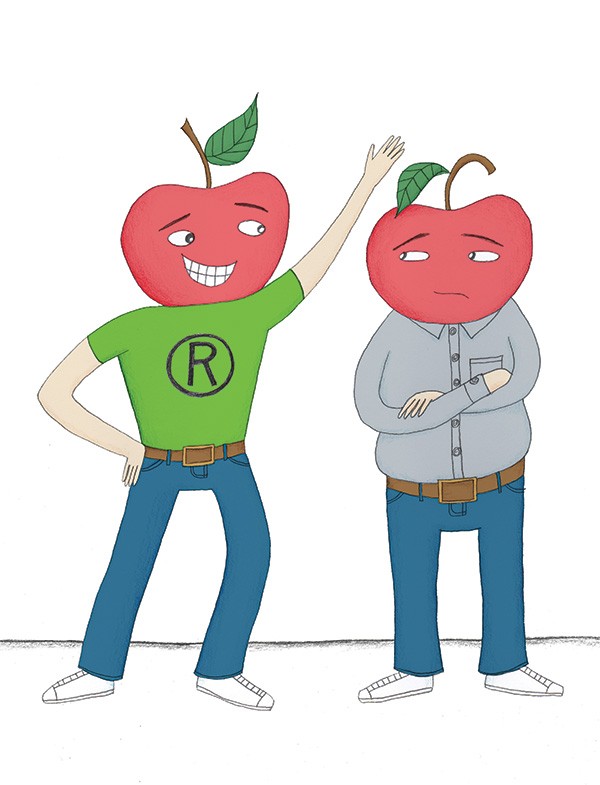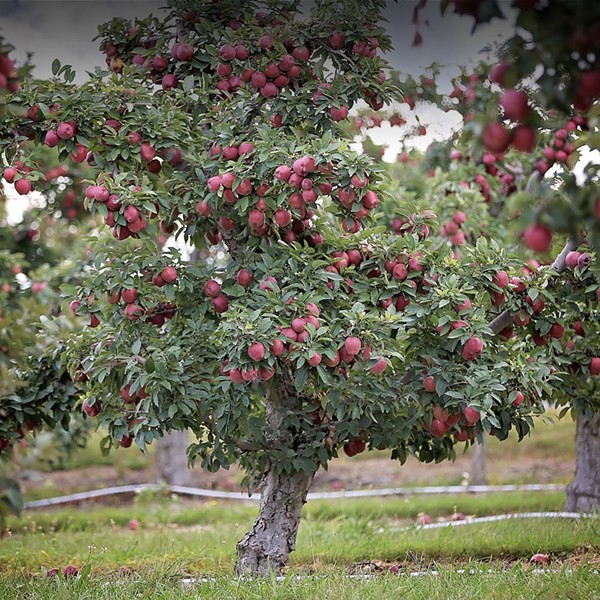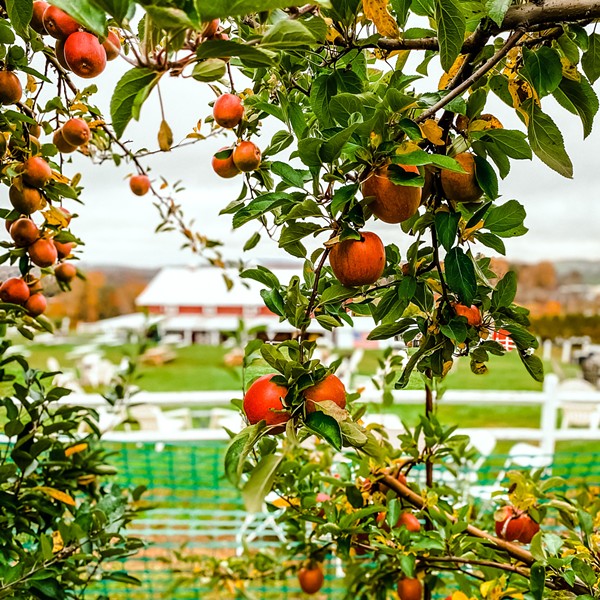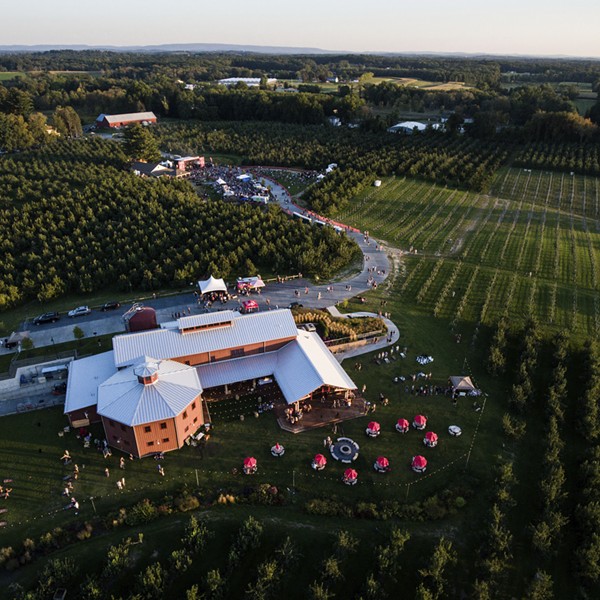They're as old as the Garden of Eden. In pie, they're all-American. Teacher-pleasers and doctor warder-offers, apples are a vision of whole-food health—you can even eat the wrapper. But come next Halloween, the fruit you might be bobbing for will be unlike any you've ever known. Apples have gone high-tech. The new Arctic® Apple (note the registered symbol) has been genetically engineered so that it doesn't turn brown when sliced. That's right—the world's first apple made with genetically modified organisms (GMOs) is coming to market soon, pending a few final hurdles toward USDA deregulation. Yet it's no surprise that en route toward its commercial debut, the laboratory-born fruit has sprouted a bit of controversy. Anti-GMO activists are upsetting the apple cart with corporate admonishments and consumer amber alerts. The Arctic® Apple's producers, a Canadian biotech company called Okanagan Specialty Fruits, says the apples are well tested and found perfectly safe to consume; without the "yuck factor" of browning, they might even inspire more healthful eating in our junk food nation. The marketing challenges, however, are fierce—just how eager will the public be to bite into the so-called Frankenapple?
Sci-fi metaphors aside, most of us are wary of GMO foods. We've heard about the superweeds that genetically modified crops have spawned, the restraints that patented seeds tend to put on farmers, and the corporate greed of GMO food megaproducers like Monsanto. Yet we do consume GMO foods, perhaps more frequently than we realize. According to the Center for Food Safety, more than 70 percent of the processed foods on supermarket shelves contain ingredients from genetically modified crops like corn, soy, and canola. That means you're getting a mouthful of GMOs every time you dig into your breakfast cereal, crackers, cookies, chips, even baby formula. The push right now among consumer groups is to get GMO foods labeled so people know what they're buying. The big question is: Are GMO foods safe to eat?
The Science Behind Science Food
Academic databases are glutted with studies about GMO products, both industry-sponsored experiments and independent trials. But rather than wade through hundreds of papers to draw conclusions, British environmentalist and author Mark Lynas—once one of the anti-GMO movement's most fervent activists, who just last year publically reversed his stance and softened his views after he "discovered science"—suggests a different way of diving in. "The most useful starting place, and I would suggest, the default position for any sensible layperson, is the statements produced by academic institutions assessing the overall evidence in this area," says Lynas. "For example, the American Association for the Advancement of Science states quite categorically that GMO crops are as safe as any other, as do the European Union science academies." Lynas warns against conspiracy theories and "anti-GMO denialism," saying that the consensus in the scientific community is that GMOs in our foods pose no known health risk. The 2012 Seralini rat study in France seemed to challenge this verdict when it found adverse health effects, including tumors, in rats fed a diet of Monsanto's Roundup Ready corn—but the experiments were later discredited and the study was retracted by the journal that published it, expunging it from the scientific record.
Of course, that's not the end of the story; with science, the case is never closed. Watchdog groups like the Organic Consumers Association (OCA) want GMO researchers to probe into areas that may be overlooked. "Our first concern is that the genetically engineered traits of these foods will actually survive in our bodies," says Alexis Baden-Mayer, the political director for OCA. "We've been told for years that they just get dissolved through digestion, which doesn't make sense because most of our food is incorporated into our body and is absorbed into our bloodstream." A 2011 study in Canada found traces of Bt—a genetically modified organism used in corn, potatoes, and other crops to ward off pests—in the blood of over 90 percent of women of reproductive age, as well as in 80 percent of fetal cord blood. "So we know that not only are these genetically engineered traits and proteins surviving digestion and accumulating in our bodies, but they're even being passed to our children before birth," says Baden-Mayer. "We don't know what effect this has, but they do leave a mark in our body."
Brave New Crops for a Brave New World
Most of the fears around GMOs revolve around what we don't know—not what we do know. But some environmentalists and farmers say we should be looking at the bigger picture. "While there are so many negative things out there about GMOs, it's also important for people to see the positive, too," says Amy Hepworth, who with her two partners owns Hepworth Farms, one of the Hudson Valley's largest organic farms, in Milton. Although Hepworth would never use GMOs herself, as organic farming prohibits them, her thinking on the issue has evolved over the years. "When I first heard of Roundup Ready, I hated the idea of a soybean that wouldn't get hurt if you sprayed herbicides on it. But then I saw that it helped decrease our use of some really toxic chemicals. No one can say it wasn't an environmental win at that time [the mid-1990s]."
Roundup has proved far from perfect, highlighting the risks of GMO agriculture on a number of levels—including the chance that modified plants will infiltrate the natural gene pool. "If you're going to use GMOs, it should be the most contained situation," says Hepworth. "People ask, 'Why use them if you're going to have that risk?' Well, the reason GMOs are here is to help us solve some bigger problems. Drought, malnutrition—there's where GMOs really have a chance to make a difference." Environmentalists like Lynas agree that GMO crops offer an opportunity for us to address the challenges of a changing climate, as well as hunger in various parts of the globe. "There are billions of us on the planet, and limited natural resources," says Hepworth. "We're blessed here in the Northeast with rainfall and spectacular ecological diversity. Other regions don't have that. When people are having malnutrition and starving in Africa, and you ban a GMO rice that has more nutrition in it, it's kind of scary. You could help millions of people. We can sit over here with our abundance and our privileged lives and say that's bad. It's weird. I'm not comfortable with that."
Apple Brown Betty, Without the Brown
Creating GMO foods out of global necessity is one thing. But does the world really need a nonbrowning apple? Some apple growers argue yes. The makers of the Arctic® Apple say their product, which doesn't bruise like other apples, will create less waste, as fewer fruits will need to be discarded. But people like Baden-Mayer don't think the benefits outweigh the risks in this instance. "The technology used in the apple, called RNA interference technology, is used to block the expression of a gene," she says. "So a gene blocker is ending up in our bodies. That's even scarier than the Bt example, because a gene blocker could influence our bodies' normal function." Supporters of the Arctic® Apple, including Lynas, say that the apple's producers are simply switching off an enzyme that causes browning and that the science is harmless; defenders say the fruit is as safe to eat as any produce grown with conventional crop-modification techniques. "You can't conventionally breed a crop to knock out a gene," says Baden-Mayer. "There are effects all up and down the DNA strand. We don't know what else happens to the apple."
We've been modifying our food since the beginning of modern agriculture in pursuit of a crispier apple, a bigger tomato, or a heartier broccoli. But some suggest that tampering with our food endlessly—even through conventional, natural means—is not without potential risk. William David, MD, says in his book Wheat Belly (Rodale, 2011) that modern wheat bears little resemblance to the wheat that our forebears ground into their daily bread—and he directly connects these changes to the rise in allergies, gluten sensitivities, and celiac disease that we have today. GMO foods could have similar effects, though we simply don't know for sure. The only solution is more clinical trials and more testing; just last year, the American Medical Association recommended that the FDA conduct mandatory, premarket safety testing of GMO foods, which we currently do not have.
Waves of Change and Fields of Dreams
GMO skeptics say that we're part of one big human experiment, kind of like juggling with apples. But Hepworth is more optimistic. "I believe in the agricultural community's ability to create good, safe food that is of zero risk to your health, just fresh fruits and vegetables. Give the people what they want—clean food, sustainable practices." For those who want to avoid GMO foods, one surefire solution is to eat exclusively organic. But after working within organic agriculture for 30 years, Hepworth is starting to see its limitations. "My position now is that local is better than organic. I once thought organic was the end all, but it's not the best agricultural practice anymore. There's so much more out there now in biotech. They're producing chemistries that have a very short life and are very effective without toxicity, very specifically targeted." It could be that the next wave of agriculture will move beyond organic, remaining toxin-free while making use of the vast array of technologies and innovations available today. Just what that will look like, and whether or not GMOs will be a part of it, is unclear right now.
Whatever you think of GMOs from a political, environmental, economic, or humanitarian standpoint—and each of these areas is complex—the bottom line from a personal health point of view is that we should steer clear of them. Not because they've been proven unsafe (they have not), but because the foods they're likely to inhabit are processed foods and fast foods, which play a role in modern health scourges from diabetes to heart disease to cancer. The Arctic® Apple could be the beginning of GMOs making their way onto supermarket produce shelves, too, requiring a new kind of consumer savvy. But it will have its competitors, including a new apple that is extremely slow to brown and was developed with conventional breeding techniques, called WA 38 (expect a sexier name when the apple comes to market around 2017). GMO labeling should be mandatory, because we have a right to know what we're eating. But we can also focus our efforts on quelling the fear mongering, and thinking positive. "Can you imagine everybody uniting to have sustainable, healthy soil and clean food? Wouldn't that be fantastic?" asks Hepworth. "We can do that. I have a lot of hope that we're going to come together with a unified agricultural system that's ecologically sustainable and healthy."


















